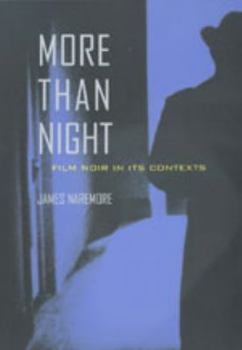More Than Night: Film Noir in Its Contexts
Select Format
Select Condition 
Book Overview
"Film noir" evokes memories of stylish, cynical, black-and-white movies from the 1940s and '50s--melodramas about private eyes, femmes fatales, criminal gangs, and lovers on the run. James Naremore's... This description may be from another edition of this product.
Format:Paperback
Language:English
ISBN:0520212940
ISBN13:9780520212947
Release Date:October 1998
Publisher:University of California Press
Length:342 Pages
Weight:1.30 lbs.
Dimensions:0.9" x 6.1" x 9.0"
Customer Reviews
2 ratings
Scholarly Analysis of Film Noir as an Idea, not a Category.
Published by Thriftbooks.com User , 19 years ago
In his Introduction, author James Naremore proposes an alternative title for his book: "Seven Ways of Looking at Film Noir". That's an accurate description of this book's contents, as each chapter explores a different angle on film noir. But to leave it at that would be misleading. "More Than Night" is a scholarly analysis of "film noir" as an idea formed ex post facto that continues to resonate through contemporary media. In other words, it is less about a particular group of films than it is about a "discourse", to use Mr. Naremore's word. Some chapters do contain discussions of particular films, themes, and styles. Naremore takes the view that films that are considered noir do not really have traits in common, so cannot be categorized in terms of style or genre-style hybrid as most film theorists do. One consequence of this approach is that Naremore considers more films to be noir than most people would. Whether one agrees with the author's premise or not, the breadth of scholarship in "More Than Night" is impressive, and even longtime noir aficionados are likely to learn something. Chapter 1 gives us an account of "The History of an Idea", starting with a history of the intellectual and cinematic climate in France from which the idea of film noir emerged in the mid-1940s. How the new crop of American crime films were interpreted by surrealist and existentialist schools of thought. This chapter continues through Paul Schrader's 1972 essay, "Notes on Film Noir". Notice that Naremore considers the "First Age of Film Noir" to be 1946-1959, as the idea was born in 1946, although many noir films were made before then. Chapter 2, "Modernism and Blood Melodrama", explains that the hard-boiled school of literature was an outgrowth of modernism, which combined with what Graham Greene called "blood melodrama" films to create film noir. Includes 3 detailed case studies: the writings of Dashiell Hammett, Graham Greene, and an analysis of Raymond Chandler and Billy Wilder's adaptation of James M. Cain's "Double Indemnity". Chapter 3, "From Dark Films to Black Lists", talks about the impact of the Production Code and challenges the idea that film noirs are basically apolitical by discussing some social-problem noirs and demonstrating that some artists tried to inject politics into their films during the black list years. Chapter 4, "Low is High", addresses the "complex relationship between economics, reception, and cultural prestige" by providing an interesting detailed study of the distinctions -and lack of distinctions- between A, B, and intermediate films of the 1940s and 1950s. The economics of modern low-budget direct-to-video thrillers is also discussed. Chapter 5, "Old Is New", makes that point that classic film noir is actually stylistically rather heterogeneous. It discusses the style of John Alton, the low-key lighting of "Out of the Past", and the appeal of black-and-white photography. The nostalgic style of "Chinatown" and the new approac
black-and-white photography and melodramatic danger
Published by Thriftbooks.com User , 24 years ago
As James Naremore notes in the introductory chapters to this book, the term "noir" has become, for film crticism and academia in general, as amorphic, uncertain and dangerous a term as the films themselves; like Jane Greer in "Out of the Past," moving in and out of the shadows as she strolls into that Mexican barroom, noir seems to occupy several levels of meaning at once (as stylistic movement, historical marker, theoretical battleground and space of nostalgic recuperation), and every new piece of data and analysis added to the voluminous corpus of work that exists seems to simultaneously cast light and shadow onto its form. How wonderful, then, that we have a critic as graceful, piercing, and generous as James Naremore writing on the genre. One of the best American writers on film-- and certainly one of the best academics writing on any subject-- Naremore brings to noir the qualities anyone familiar with such previous works as The Films of Vincente Minnelli or The Magic World of Orson Welles will recognize-- intelligence, accessibility, thoroughness and an abiding love of the subject matter. He does a good job of sharing with the reader the insights and breakthroughs of psychoanalytic and feminist readings of the films, while offering his own (often different) readings and new historical connections (quick quiz to anyone who thinks they know everything about noir-- who is Boris Vian? And why does Naremore think he's the key figure in noir's history?), as well as updating and expanding the boundaries of the form to include such works as L.A. Confidential and John Woo's The Killer. And as always, he writes in a voice that wraps around the reader like a cloud of cigarette smoke, as stylish, rich and alluring as the films under discussion.






